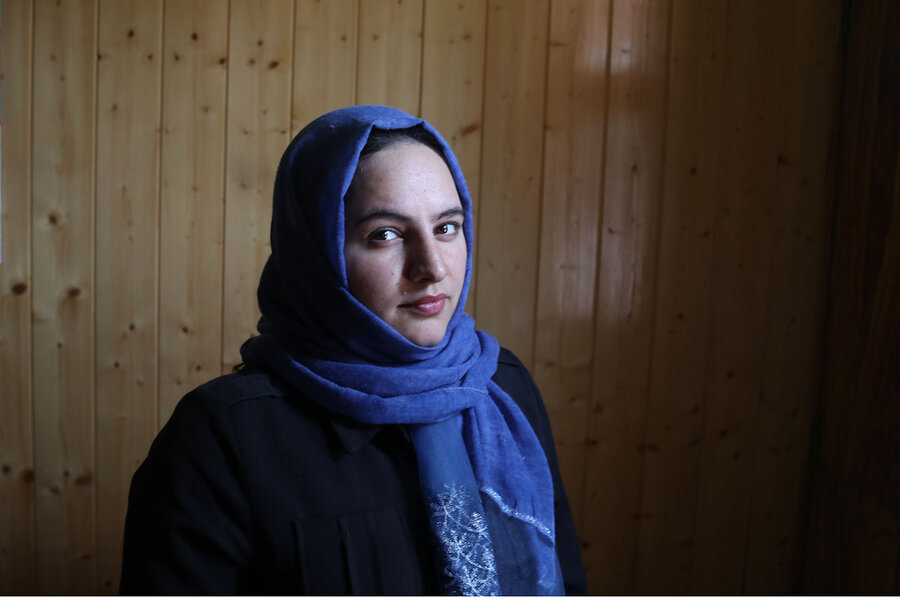Kashmir’s media survived blackout – but warn of shrinking freedoms
Loading...
| Srinagar, India
Nearly one year ago, New Delhi stripped Kashmir of its special status, carving it into two union territories ruled directly by the capital. For many months, Kashmir lived under a lockdown, with communication services cut off, which officials argued was needed to maintain order.
And yet journalists found a way to report. Some, unable to access the internet, sent materials on thumb drives to New Delhi.
Why We Wrote This
How do you report in a communications blackout? For months, Kashmir’s journalists found a way. Now, with most internet restored, they still face challenges – and tough decisions about the risks of reporting.
But now, with much access restored, local journalists say they still face an increasingly challenging environment – one that some fear could make independent reporting all but impossible. A new media policy that allows authorities to examine and punish reporting they deem detrimental to India’s “sovereignty and integrity,” has added to concerns, and many reporters have been questioned by police.
Kashmiri journalists are left with just two options, says editor Anuradha Bhasin: “Either they become vehicles of government publicity departments or continue their work professionally at the risk of facing consequences.”
But there have been brief bright spots this spring, in international awards to four local photojournalists – including Pulitzer Prizes.
Winning an award from the International Women’s Media Foundation “was an acknowledgement that the world is witnessing and reading our stories,” says Masrat Zahra. “It gave us more strength and courage.”
Two months since photojournalist Masrat Zahra was booked by Indian police under an anti-terror law, she says, “I still fear that I might be detained anytime.”
A resident of Srinagar, the summer capital of Indian-administered Kashmir, Ms. Zahra was charged in late April for posting her work on social media – including a photo of a protester with a banner of popular Kashmiri rebel commander Burhan Wani, who was killed in July 2016. In a statement, police said Ms. Zahra was “uploading photographs which can provoke the public to disturb law and order ... tantamount to glorify anti-national activities and dent image of law enforcing agencies besides causing disaffection against the country.”
Born and raised in Srinagar, she often watched protests against security forces and Indian rule, but “found it strange that the photographers were only men.” In university, she enrolled in science classes – but secretly studied for a journalism program, against her parents’ wishes.
Why We Wrote This
How do you report in a communications blackout? For months, Kashmir’s journalists found a way. Now, with most internet restored, they still face challenges – and tough decisions about the risks of reporting.
Today, at 26, she is one of Kashmir’s only women photojournalists – and even has support from her parents. But over the past year, Ms. Zahra and other journalists in long-troubled Kashmir, one of the world’s most militarized regions, have faced increasing risks in their work – risks that could make independent reporting all but impossible, some argue. They include a monthslong internet shutdown for much of the past year, the longest-ever imposed in a democracy.
Ms. Zahra is not the only journalist in Kashmir to face questioning. Another journalist, Gowhar Geelani, was also booked under the same law – the Unlawful Activities Prevention Act (UAPA), which can carry sentences of up to seven years – for the same reasons. While Ms. Zahra and Mr. Geelani have been released, the investigations continue. Several other journalists have been summoned by police in the past few months, or accused of reporting “fake news.”
Increasing risks
Islamabad and New Delhi have disputed the wider Kashmir region for decades, and thousands have been killed as rebels fight Indian rule. Indian-controlled Kashmir and Jammu was the country’s only Muslim-majority state – until last August 5, when the Indian government unilaterally stripped it of its semi-autonomous status and carved it into two union territories ruled directly by New Delhi.
Officials imposed a strict curfew and cut communication channels, which they argued was needed to restore order and avoid violence amid protests. Many reporters without internet facilities sent text, photographs, and videos in thumb drives to New Delhi.
Anuradha Bhasin, executive editor of the Kashmir Times, says that in the past, successive governments have made attempts to gag media by bringing in undemocratic policies, actions, and laws, but “the media fraternity has been successful in thwarting such attempts.”
However, she adds, “the present policy is extremely stringent and we seem to be living in different times. Unless the media is united and ready to challenge this ugly policy, I don’t see much hope for the future.”
Ms. Zahra, who has since continued to work, says that journalists are constantly being harassed, intimidated, summoned, and booked.
“The case has been a shock for me. I’m new in the field and getting booked under this draconian law was really unexpected. I could not sleep for so many nights,” she says. “Mental trauma continues, but I also don’t want to stop working because I think all journalists in Kashmir face such pressures and we have to be ready for it.”
Similarly, the editor of a news website in south Kashmir, Qazi Shibli, was detained last summer and booked under the Public Safety Act after tweeting and reporting on the deployment of troops in Kashmir, just before the state’s special status was revoked. He spent nine months in a jail in Uttar Pradesh, some 660 miles from home, accused of “anti-national activities.” Under the law, a person can be imprisoned for up to two years without trial.
“I have been seeing psychiatrists and doctors as well. It’s just that the solitary confinement of nearly nine months, with a rare human visit now and then, has caused deep psychological distress,” says Mr. Shibli, who was released in April and has since restarted his work.
In May, a new, 53-page media policy was put in place, allowing officials to detect and punish “fake news” and media they deem detrimental to the “sovereignty and integrity” of India. The policy also adds that government agencies will do background checks of newspaper editors, to determine which are eligible to run government ads; and of staffers, for accreditation.
Most journalists view the rules as an attempt to encourage self-censorship. Ms. Bhasin, whose newspaper has been barred from publishing government advertisements, says that it is an attempt to “kill journalism through a systemic policy of surveillance and control of media.”
“Much of this was already happening,” she says, adding that the new policy is not only “a tool to suppress journalists who ask uncomfortable questions but also individuals who exercise their right to free expression.” Kashmiri journalists are left with just two options, she adds: “either they become vehicles of government publicity departments or continue their work professionally at the risk of facing consequences.” Though much internet access has been restored, most major newspapers here have continued to refrain from questioning the government or reporting on conflict.
Outside appreciation
Yet this spring, Kashmir’s media had a moment to celebrate: Three photojournalists working with the Associated Press – Dar Yasin and Mukhtar Khan, who are from Kashmir, and Channi Anand, who is from Jammu – won the Pulitzer Prize for their photographs of Kashmir’s lockdown. Within hours of the announcement, India’s social media and several members of the ruling party accused the Pulitzer board of being biased.
At such a difficult time, “to win the most prestigious award of course is encouraging,” says Mr. Shibli, expressing his gratitude to the journalists. “The world needs to see a Kashmiri journalist is putting enough at stake to present them the realities from ground zero.”
“Despite all odds people here continued to work, even if it meant smuggling pen drives [USBs] out of Kashmir to send pictures and videos,” says Ms. Zahra. “This shows the level of dedication and hard work. In the process of telling stories, journalists here become stories.”
Amid this, the recognition has shown how journalism in Kashmir plays a significant role. That message set in after the Pulitzer Prize in May, and again in June when Ms. Zahra won the 2020 Anja Niedringhaus Courage in Photojournalism Award from the International Women’s Media Foundation.
Speaking on behalf of Kashmiri journalists, Ms. Zahra says that her award was “a recognition of our hard work and honesty towards the profession. It was an acknowledgement that the world is witnessing and reading our stories. It gave us more strength and courage.”









